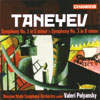Taneyev Symphonies Nos 1 & 3
They may not fill concert halls but these works fill an important gap
View record and artist detailsRecord and Artist Details
Composer or Director: Sergey Ivanovich Taneyev
Genre:
Orchestral
Label: Chandos
Magazine Review Date: 6/2007
Media Format: CD or Download
Media Runtime: 64
Mastering:
Stereo
DDD
Catalogue Number: CHAN10390

Tracks:
| Composition | Artist Credit |
|---|---|
| Symphony No 1 |
Sergey Ivanovich Taneyev, Composer
Russian State Symphony Orchestra Sergey Ivanovich Taneyev, Composer Valéry Polyansky, Conductor |
| Symphony No 3 |
Sergey Ivanovich Taneyev, Composer
Russian State Symphony Orchestra Sergey Ivanovich Taneyev, Composer Valéry Polyansky, Conductor |
Author: David Fanning
There are plenty of pre-Soviet Russian symphonies awaiting disinterment, but none by a more major historical figure than these two. Taneyev lived by the same high critical standards he expected from others, and of his four symphonies he only approved the last for publication – the widely respected if still relatively little-known C minor (which is why it was for long numbered, confusingly, as No 1). The B flat major (chronologically No 2) was left lacking a scherzo. Those two works were recorded by Polyansky on Chandos (11/02). Taneyev’s first composed symphony, in E minor, was the work of a 17-year-old student, dutifully ticking the prescribed boxes for his graduation from Moscow Conservatoire. As so often in the academic Russian tradition, the Scherzo is the most striking movement; the finale, by contrast, puts its folksong material through so many harmonic and contrapuntal routines that one almost imagines it crying for mercy.
The Third Symphony, in D minor and dedicated to Arensky, drew Tchaikovsky’s praise for its musical content but also his reservations about the “abstract” (ie non-orchestral) nature of the material. That seems a just assessment. The first movement, like Beethoven’s Eroica, Schumann’s Rhenish and Nielsen’s Espansiva, moves in a liberally cross-accented triple metre (a useful aide-mémoire that these should all be third symphonies). It is in many ways no less ingenious than those works but never achieves lift-off in the way they do; the same goes for the Scherzo, whose strategy for integrating the Trio is resourceful but hardly revelatory. The modest Intermezzo is easy to like as a pleasantly relaxing episode, but would be more effective placed in more dramatic surroundings.
Polyansky and the Russian State Symphony have done Taneyev a superb service with these thoroughly prepared, expertly recorded performances. The music itself may be too firmly tied to academic apron-strings to be viable in the concert hall, and the composer’s verdict in not releasing them was surely the right one. But these are still need-to-know pieces for anyone interested in the Russian symphonic repertoire.
The Third Symphony, in D minor and dedicated to Arensky, drew Tchaikovsky’s praise for its musical content but also his reservations about the “abstract” (ie non-orchestral) nature of the material. That seems a just assessment. The first movement, like Beethoven’s Eroica, Schumann’s Rhenish and Nielsen’s Espansiva, moves in a liberally cross-accented triple metre (a useful aide-mémoire that these should all be third symphonies). It is in many ways no less ingenious than those works but never achieves lift-off in the way they do; the same goes for the Scherzo, whose strategy for integrating the Trio is resourceful but hardly revelatory. The modest Intermezzo is easy to like as a pleasantly relaxing episode, but would be more effective placed in more dramatic surroundings.
Polyansky and the Russian State Symphony have done Taneyev a superb service with these thoroughly prepared, expertly recorded performances. The music itself may be too firmly tied to academic apron-strings to be viable in the concert hall, and the composer’s verdict in not releasing them was surely the right one. But these are still need-to-know pieces for anyone interested in the Russian symphonic repertoire.
Discover the world's largest classical music catalogue with Presto Music.

Gramophone Digital Club
- Digital Edition
- Digital Archive
- Reviews Database
- Full website access
From £8.75 / month
Subscribe
Gramophone Full Club
- Print Edition
- Digital Edition
- Digital Archive
- Reviews Database
- Full website access
From £11.00 / month
Subscribe
If you are a library, university or other organisation that would be interested in an institutional subscription to Gramophone please click here for further information.




